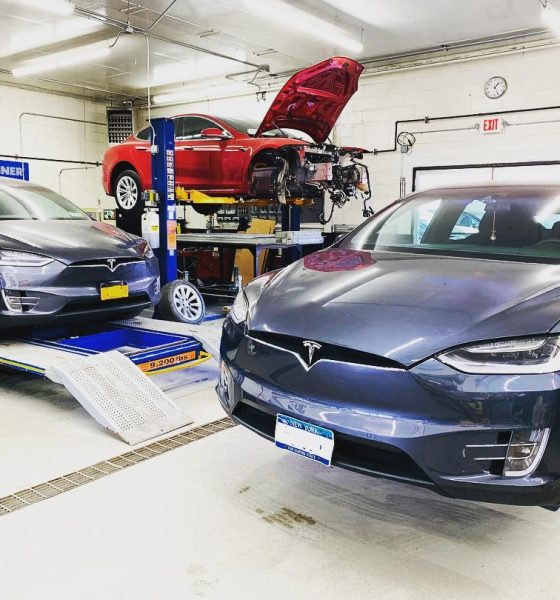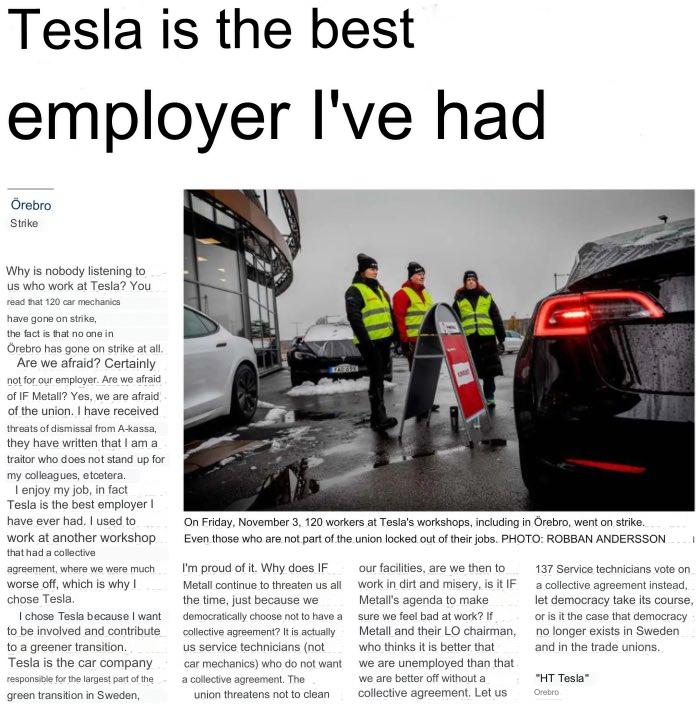

News
Tesla employee laments escalating union strike in Sweden: “Why is nobody listening to us?”
Amidst the contrasting narratives surrounding the ongoing strike against Tesla in Sweden, there is one group that has mostly remained silent — Tesla’s employees themselves. And if a recent post from what appears to be a Tesla employee is any indication, it would appear that the company’s workers are getting quite exasperated with the union’s ongoing strikes.
There are mostly two contrasting arguments in the escalating conflict between Tesla Sweden and IF Metall. The union claims that it is fighting to secure a collective agreement with Tesla for the sake of the company’s workers. Tesla, on the other hand, has claimed that it already offers “equivalent or better agreements than those covered by collective bargaining.”
An opinion piece published in Nerikes Allehanda (NA), a daily newspaper in Sweden, suggested that Tesla employees are getting frustrated because nobody seems to be listening to the people who are actually working for the electric vehicle maker. The piece’s author clarified that Tesla workers are afraid, not of the electric vehicle maker, but of the union.
Following is a translation of the Tesla employee’s opinion piece (translated using Google Translate).


“Why is nobody listening to us who work at Tesla? You read that 130 car mechanics have gone on strike. The fact is that no one in Örebro has gone on strike at all.
“Are we afraid? Absolutely not for our employer. Are we afraid of IF Metall? Yes, we are afraid of the union. I have received threats of dismissal from A-kassa. They have written that I am a traitor who does not stand up for my colleagues, etc.
“I enjoy my job. In fact, Tesla is the best employer I have ever had. I used to work at another workshop that had a collective agreement, where we were much worse off, which is why I chose Tesla.
“I chose Tesla because I want to be part of and contribute to a greener transition. Tesla is the car company that is responsible for the largest part of the green transition in Sweden, and I’m proud of it.
“Why does IF Metall continue to threaten us all the time just because we democratically choose not to have a collective agreement? It is actually us service technicians (not car mechanics) who do not want a collective agreement.
“The union threatens not to clean our facilities. Are we then to work in dirt and misery? Is it IF Metall’s agenda to make sure we feel bad at work? If Metall and their LO chairman, who thinks it is better that we are unemployed than that we are better off without a collective agreement.
“Let us 137 service technicians vote on a collective agreement instead. Let democracy have its way. Is it the case that democracy does not exist in Sweden and in the trade unions anymore?”
The battle between Tesla Sweden and IF Metall does not seem to be approaching its end yet. Just recently, IF Metall noted that it was looking to stop vehicle production at Giga Berlin, since a Swedish company that produces aluminum profiles for the Model Ys in the plant has become involved in a sympathy strike and blockade. Since the profiles are crucial for the Model Y’s crash safety, the production of the vehicle would get disrupted once the sympathy strike’s effects become evident.
IF Metall strike general Veli-Pekka Säikkälä described the strategy. “There will be serious disruptions in production, and that is of course the aim… Without that detail, you cannot deliver the car… There is a very high risk that there will be serious disruptions in production, and that is, of course, the purpose for us to get Tesla to sign a collective agreement,” he said.
Don’t hesitate to contact us with news tips. Just send a message to simon@teslarati.com to give us a heads up.

News
Tesla China quietly posts Robotaxi-related job listing
Tesla China is currently seeking a Low Voltage Electrical Engineer to work on circuit board design for the company’s autonomous vehicles.

Tesla has posted a new job listing in Shanghai explicitly tied to its Robotaxi program, fueling speculation that the company is preparing to launch its dedicated autonomous ride-hailing service in China.
As noted in the listing, Tesla China is currently seeking a Low Voltage Electrical Engineer to work on circuit board design for the company’s autonomous vehicles.
Robotaxi-specific role
The listing, which was shared on social media platform X by industry watcher @tslaming, suggested that Tesla China is looking to fill the role urgently. The job listing itself specifically mentions that the person hired for the role will be working on the Low Voltage Hardware team, which would design the circuit boards that would serve as the nervous system of the Robotaxi.
Key tasks for the role, as indicated in the job listing, include collaboration with PCB layout, firmware, mechanical, program management, and validation teams, among other responsibilities. The role is based in Shanghai.
China Robotaxi launch
China represents a massive potential market for robotaxis, with its dense urban centers and supportive policies in select cities. Tesla has limited permission to roll out FSD in the country, though despite this, its vehicles have been hailed as among the best in the market when it comes to autonomous features. So far, at least, it appears that China supports Tesla’s FSD and Robotaxi rollout.
This was hinted at in November, when Tesla brought the Cybercab to the 8th China International Import Expo (CIIE) in Shanghai, marking the first time that the autonomous two-seater was brought to the Asia-Pacific region. The vehicle, despite not having a release date in China, received a significant amount of interest among the event’s attendees.
Elon Musk
Elon Musk and Tesla AI Director share insights after empty driver seat Robotaxi rides
The executives’ unoccupied tests hint at the rapid progress of Tesla’s unsupervised Robotaxi efforts.

Tesla CEO Elon Musk and AI Director Ashok Elluswamy celebrated Christmas Eve by sharing personal experiences with Robotaxi vehicles that had no safety monitor or occupant in the driver’s seat. Musk described the system’s “perfect driving” around Austin, while Elluswamy posted video from the back seat, calling it “an amazing experience.”
The executives’ unoccupied tests hint at the rapid progress of Tesla’s unsupervised Robotaxi efforts.
Elon and Ashok’s firsthand Robotaxi insights
Prior to Musk and the Tesla AI Director’s posts, sightings of unmanned Teslas navigating public roads were widely shared on social media. One such vehicle was spotted in Austin, Texas, which Elon Musk acknowleged by stating that “Testing is underway with no occupants in the car.”
Based on his Christmas Eve post, Musk seemed to have tested an unmanned Tesla himself. “A Tesla with no safety monitor in the car and me sitting in the passenger seat took me all around Austin on Sunday with perfect driving,” Musk wrote in his post.
Elluswamy responded with a 2-minute video showing himself in the rear of an unmanned Tesla. The video featured the vehicle’s empty front seats, as well as its smooth handling through real-world traffic. He captioned his video with the words, “It’s an amazing experience!”
Towards Unsupervised operations
During an xAI Hackathon earlier this month, Elon Musk mentioned that Tesla owed be removing Safety Monitors from its Robotaxis in Austin in just three weeks. “Unsupervised is pretty much solved at this point. So there will be Tesla Robotaxis operating in Austin with no one in them. Not even anyone in the passenger seat in about three weeks,” he said. Musk echoed similar estimates at the 2025 Annual Shareholder Meeting and the Q3 2025 earnings call.
Considering the insights that were posted Musk and Elluswamy, it does appear that Tesla is working hard towards operating its Robotaxis with no safety monitors. This is quite impressive considering that the service was launched just earlier this year.
Elon Musk
Starlink passes 9 million active customers just weeks after hitting 8 million
The milestone highlights the accelerating growth of Starlink, which has now been adding over 20,000 new users per day.

SpaceX’s Starlink satellite internet service has continued its rapid global expansion, surpassing 9 million active customers just weeks after crossing the 8 million mark.
The milestone highlights the accelerating growth of Starlink, which has now been adding over 20,000 new users per day.
9 million customers
In a post on X, SpaceX stated that Starlink now serves over 9 million active users across 155 countries, territories, and markets. The company reached 8 million customers in early November, meaning it added roughly 1 million subscribers in under seven weeks, or about 21,275 new users on average per day.
“Starlink is connecting more than 9M active customers with high-speed internet across 155 countries, territories, and many other markets,” Starlink wrote in a post on its official X account. SpaceX President Gwynne Shotwell also celebrated the milestone on X. “A huge thank you to all of our customers and congrats to the Starlink team for such an incredible product,” she wrote.
That growth rate reflects both rising demand for broadband in underserved regions and Starlink’s expanding satellite constellation, which now includes more than 9,000 low-Earth-orbit satellites designed to deliver high-speed, low-latency internet worldwide.
Starlink’s momentum
Starlink’s momentum has been building up. SpaceX reported 4.6 million Starlink customers in December 2024, followed by 7 million by August 2025, and 8 million customers in November. Independent data also suggests Starlink usage is rising sharply, with Cloudflare reporting that global web traffic from Starlink users more than doubled in 2025, as noted in an Insider report.
Starlink’s momentum is increasingly tied to SpaceX’s broader financial outlook. Elon Musk has said the satellite network is “by far” the company’s largest revenue driver, and reports suggest SpaceX may be positioning itself for an initial public offering as soon as next year, with valuations estimated as high as $1.5 trillion. Musk has also suggested in the past that Starlink could have its own IPO in the future.








